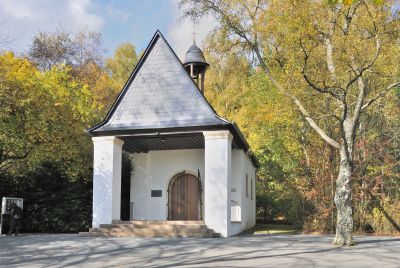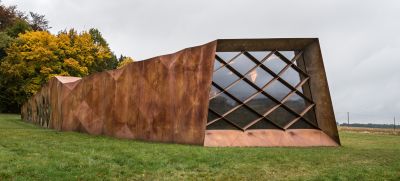Polish victims in the Hinzert SS concentration camp

Rather than contributing to any public remembrance, the term “Ehrenfriedhof” (“honorary cemetery”), which is taken from the French, and which is used in the German to refer to the burial of members of the military, rather cast a veil over the true nature of the site. This changed as a result of the growing level of interest in that period of history during the 1980s. Remembrance of the concentration camp and the prisoners who were murdered here finally manifested itself in the public arena on 11 October 1986 with the unveiling of a sculpture by Lucien Wercollier (1908–2002), a former prisoner in Hinzert.[14] Wercollier, who after 1941 was no longer allowed to exhibit his work, joined the resistance. In the autumn of 1942, he was arrested along with many others for participating in the Luxembourg general strike and was deported to Hinzert. From there, he was later taken to the Lublin-Majdanek concentration and death camp. He also managed to survive this camp, and was able to return to Luxembourg in June 1945. Wercollier, who dedicated himself to abstract art, became one of the most highly regarded contemporary artists in Luxembourg.[15] His bronze sculpture in Hinzert shows three stelae that taper upwards. The abstract forms call to mind the figures of three prisoners. They are bent, facing towards each other and towards a brazier in their midst. An inscription in Latin and German reads: “Imbued with humanity, peace and justice”.
The work to examine and portray the history of the camp was also met with resistance, with which the very active teacher from Hermeskeil, Volker Schneider, who worked on the topic with his pupils, was confronted, among others. In 1989, an association was founded to support a documentation and meeting centre. Two years later, responsibility for maintaining the concentration camp memorial sites became an important focus of the work of the federal state government. These developments resulted in the creation of a concept and in 2002, an invitation to tender was issued for the architectural design of a new documentation and meeting centre. The centre was officially opened on 10 December 2005. The building contains a permanent exhibition created by the Centre for Political Education of Rhineland-Palatinate (Landeszentrale für politische Bildung).[16]
Julia Röttjer, May 2022
[14] Bader, Uwe; Welter, Beate: Das SS-Sonderlager/KZ Hinzert, in: Benz, Wolfgang; Distel, Barbara (eds.): Der Ort des Terrors. Geschichte der nationalsozialistischen Konzentrationslager . Vol. 5: Hinzert, Auschwitz, Neuengamme, München 2007, p. 17–74, here p. 38. Wercollier had already installed a wooden sculpture of Maria as the “comforter of the afflicted” (Maria Consolatrix afflictorum), the patron saint of Luxembourg, in the chapel of conciliation. For more information, see the Förderverein Gedenkstätte KZ Hinzert e.V. (ed.): Schweigen durchbrechen. 20 Jahre Förderverein Gedenkstätte KZ Hinzert 1989 – 2009, Trier 2009, p. 11.
[15] See Muller, Joseph-Émile: Lucien Wercollier, Paris 1976.
[16] Bader, Uwe; Welter, Beate: Das SS-Sonderlager/KZ Hinzert, in: Benz, Wolfgang; Distel, Barbara (ed.): Der Ort des Terrors. Geschichte der nationalsozialistischen Konzentrationslager . Vol. 5: Hinzert, Auschwitz, Neuengamme, München 2007, p. 17–74, here p. 38 f. Website of the memorial centre: https://www.gedenkstaette-hinzert-rlp.de/en/ss-special-camp/concentration-camp-hinzert (12/1/2022).









